Glass enamel firing temperatures matter because they directly control whether your powdered glass particles fuse properly to create strong adhesion between 1400°F and 1500°F. When you fire below this range, you’ll get bubbles, pits, and poor bonding. Fire too hot above 1500°F, and you’ll darken colors and create cloudiness in transparent enamels. Different enamel types, metal substrates, and thicknesses require precise temperature adjustments to prevent cracking and achieve ideal results through proper molecular fusion.
Understanding Temperature Ranges for Different Enamel Types
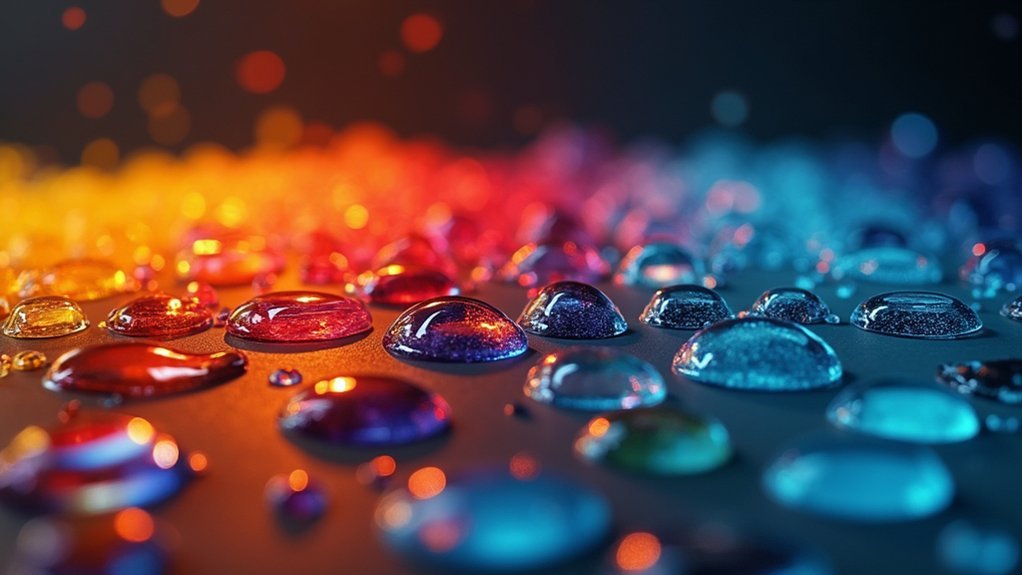
When working with glass enamels, you’ll need to fire them between 1300°F and 1500°F, though the exact temperature depends on your specific enamel type and desired finish.
Lead-free enamels typically fire successfully below 1500°F, while leaded varieties often require higher temperatures for ideal results.
Lead-free enamels fire below 1500°F, while leaded varieties need higher temperatures for optimal results.
Each enamel type has distinct melting points and viscosities that directly affect your firing requirements.
You’ll find that enamel hardness and flow behavior markedly influence both firing temperature and timing.
The thickness of your glass piece also plays a vital role—thicker pieces may need adjusted temperatures for proper adhesion.
Since these characteristics vary between manufacturers and formulations, you’ll want to test each enamel type carefully to determine its specific firing temperature requirements for successful results.
The Science Behind Enamel Fusion and Metal Compatibility
Understanding enamel fusion requires grasping the molecular-level changes that occur when powdered glass particles melt and bond to metal surfaces.
At firing temperatures between 1400°F and 1500°F, glass melts and creates strong adhesion to your metal substrate. However, metal compatibility determines success—copper and sterling silver expand differently, affecting how enamel adheres during cooling.
You must match the coefficient of expansion between your enamel and metal. For example, 104 COE glass enamels work perfectly with copper but won’t bond properly with other glass types.
Accurate firing temperatures prevent under-melting or color loss from over-firing.
Pre-testing enamel on your intended metal helps you determine the best firing temperature and timing, ensuring successful fusion and desired aesthetic outcomes in your finished piece.
Temperature Effects on Transparent Vs Opaque Enamel Performance
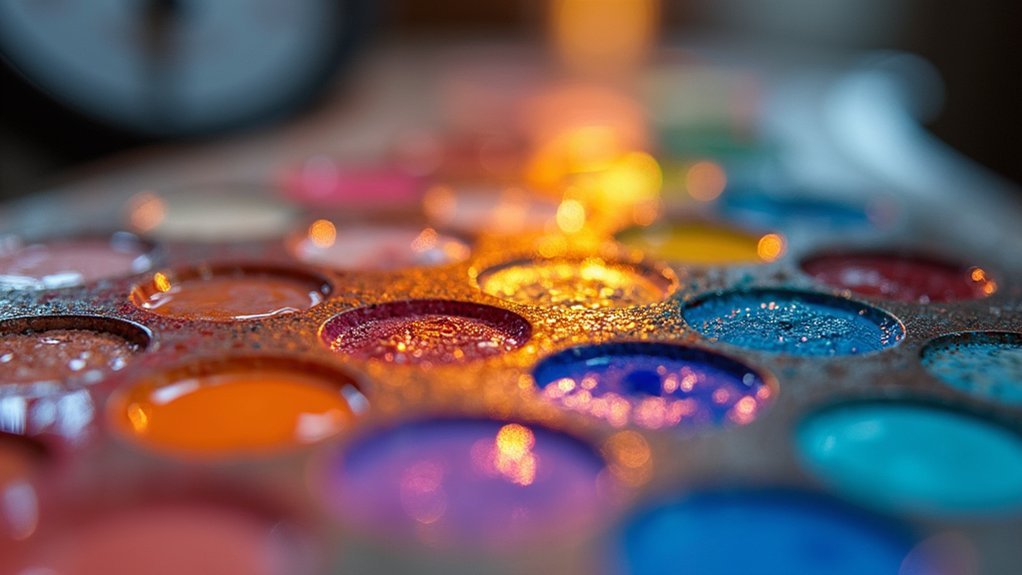
You’ll find that transparent enamels demand precise temperature control to achieve crystal-clear results, typically requiring firing at 1400-1500°F to prevent cloudiness from incomplete melting.
Opaque enamels aren’t as temperamental—they’ll maintain their coverage and color integrity even at slightly lower temperatures, making them more forgiving during the firing process.
Understanding these different heat requirements becomes critical since firing transparent enamels too low creates murky results, while excessive heat can dull opaque colors or cause unwanted metal substrate reactions.
Transparent Clarity Temperature Control
Although transparent and opaque enamels share similar basic firing techniques, their temperature requirements differ markedly in ways that’ll directly impact your finished piece. Transparent enamels demand precise temperature control between 1300-1500°F to achieve ideal clarity, while opaque enamels offer more forgiving firing ranges.
Over-firing transparent enamels creates cloudiness and destroys their visual characteristics, whereas lower temperatures enhance vibrancy.
Key factors for transparent enamel success:
- Temperature precision – Stay within narrow ranges to prevent bubbling and maintain glass-like clarity
- Viscosity management – Control flow properties through careful temperature monitoring for even settling
- Metal showcase – Proper firing preserves the underlying metal’s appearance without enamel distortion
Unlike opaque enamels that mask imperfections, transparent varieties expose every firing mistake, making temperature mastery essential.
Opaque Coverage Heat Requirements
Opaque enamels demand higher firing temperatures than their transparent counterparts, typically requiring 1450-1500°F to achieve complete coverage and strong metal adhesion. These higher temperatures enhance opacity and create the glossy, vibrant finish you’re seeking.
However, you’ll need precise temperature control since prolonged firing can darken opaque enamels and compromise their color intensity.
When planning your firing schedule, remember that transparent enamels fire successfully at lower temperatures around 1400°F. This temperature difference affects your layering techniques—you should fire opaque enamels first as your base layer, then apply transparent enamels on top.
This approach prevents the higher firing temperatures needed for ideal adhesion of opaque enamels from damaging the delicate clarity of transparent layers above them.
Lead-Free Vs Traditional Enamel Temperature Requirements
You’ll notice significant temperature differences when working with lead-free versus traditional enamels, as lead-free formulations typically fire at lower temperatures around 1450-1500°F compared to traditional lead-bearing enamels that can handle temperatures exceeding 1600°F.
This temperature variation directly impacts your firing schedule and requires careful adjustment to achieve proper fusion without compromising the enamel’s integrity.
Beyond performance considerations, you’re also dealing with important safety factors that influence both your health during application and the final product’s suitability for food-related uses.
Temperature Range Differences
When you’re choosing between lead-free and traditional enamels, the most significant difference you’ll encounter is their firing temperature requirements.
Lead-free enamels typically fire successfully at lower temperatures, around 1450-1500°F, while traditional enamels often demand higher heat—sometimes reaching 1600°F for special effects.
These varying melting points mean you can’t simply swap one enamel type for another without adjusting your kiln settings.
Understanding these temperature ranges is crucial for successful enameling:
- Lead-free enamels work effectively below 1500°F, making them more energy-efficient
- Traditional enamels require higher firing temperatures but offer expanded creative possibilities
- Incorrect temperatures cause poor adhesion and compromise color integrity
Proper temperature management guarantees your enamel fuses correctly without damaging the underlying metal or creating undesirable finishes.
Firing Safety Considerations
Beyond temperature considerations, safety becomes your primary concern when working with different enamel types. Lead-bearing enamels pose significant health risks, making lead-free enamels the safer choice for your projects.
When using any enamel type, you’ll need essential safety precautions including working in a well-ventilated area and wearing appropriate protective gear.
Lead-free enamels require precise firing temperatures below 1500°F to achieve proper adhesion without bubbling or cracking. You must carefully monitor both temperature and timing, as incorrect settings can cause inadequate fusing or excessive oxidation, especially with silver or copper bases.
While lead-free alternatives eliminate toxic exposure risks, they still demand the same rigorous safety protocols to protect your health during the firing process.
How Metal Substrate Choice Influences Firing Temperature
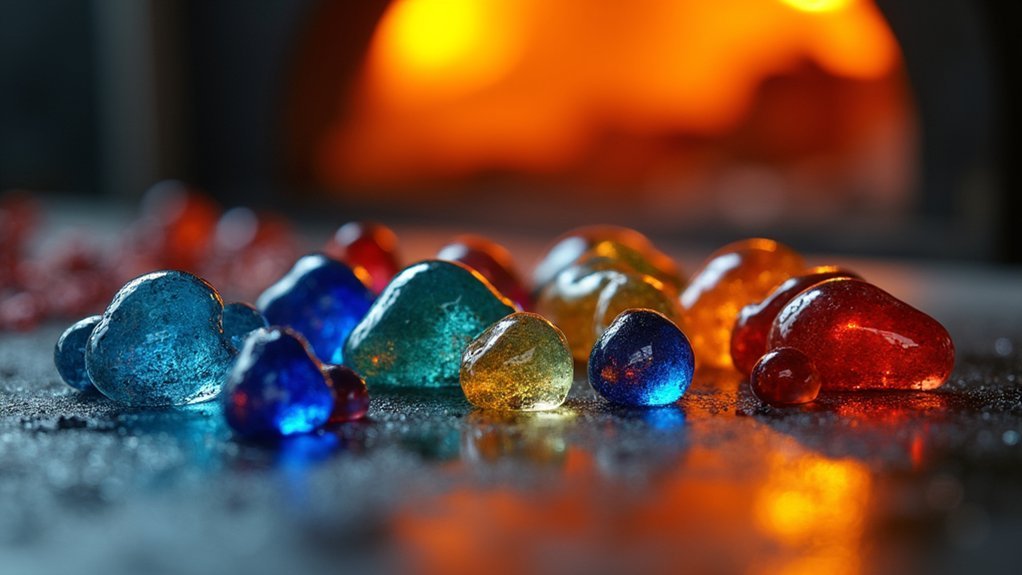
The metal substrate you choose greatly impacts your firing temperature requirements, creating a cascade of technical considerations that’ll determine your enameling success.
Copper surface demands 1450-1500°F for proper fusion, while sterling silver operates at cooler 800-900°F ranges to prevent oxidation damage. These thermal expansion rates directly affect how enamel particles bond during cooling phases.
Your substrate thickness influences firing durations considerably. Thicker pieces need extended heating periods for even heat penetration, while thin metals reach ideal temperatures quickly.
Sterling silver requires depletion gilding preparation, affecting your overall firing approach.
- Copper withstands aggressive firing schedules with excellent enamel adhesion at high temperatures
- Fine silver’s low expansion rate demands careful temperature control when enamel is fired
- High carbon steel’s structural integrity allows diverse firing techniques unavailable with softer metals
Preventing Common Temperature-Related Defects and Failures
While precise temperature control forms the foundation of successful enameling, you’ll encounter specific defects that signal when your firing parameters have gone awry.
When your firing temperatures drop below 1400°F, you’ll notice bubbles and pits forming as enamel fails to adhere properly to the glass surface. Conversely, over-firing above 1500°F darkens your colors, particularly cadmium and selenium-based hues, ruining your intended aesthetic.
Temperature precision between 1400°F and 1500°F prevents bubbling, pitting, and color degradation in glass enameling work.
You must maintain consistent temperatures throughout the process—fluctuations create uneven finishes that compromise both appearance and structural integrity.
Monitor your kiln carefully and implement gradual cooling cycles to relieve thermal stress. These precautions prevent cracking and guarantee your glass enamel pieces maintain their beauty and durability over time.
Kiln Vs Torch Firing Temperature Considerations
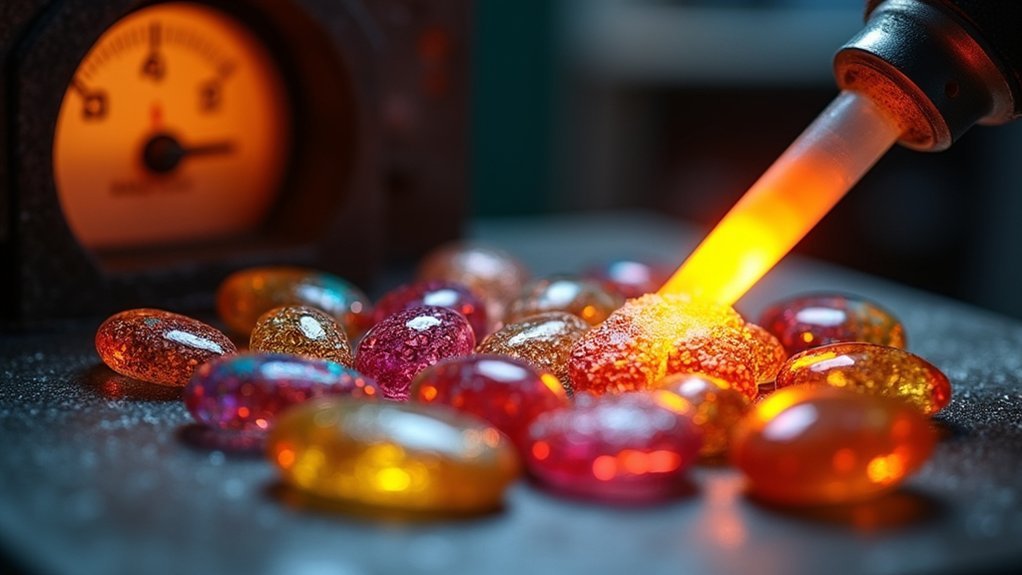
Understanding temperature defects prepares you for a fundamental choice: kiln firing versus torch firing, each method demanding distinct temperature approaches.
Kiln firing temperatures for glass enamels range from 1300-1500°F, while torch firing operates at 1450-1600°F. Your firing time varies dramatically between methods—kiln firing requires 1-5 minutes versus torch firing’s few seconds.
Key temperature considerations include:
- Equipment precision: Use pyrometers for accurate temperature readings in kilns, while maintaining strict flame control during torch firing.
- Heat distribution: Kiln firing provides even heating, whereas torch firing demands careful movement to prevent hot spots.
- Risk management: Both methods require proper temperature management to avoid incomplete fusing or enamel damage.
Choose your method based on project requirements and temperature control capabilities.
Achieving Optimal Results Through Temperature Control Techniques
How do you transform basic firing knowledge into consistently excellent results? Master temperature control by maintaining your firing temperature between 1300-1500°F for lead-free enamels. This range guarantees proper fusion without compromising your glass substrate.
Master temperature control between 1300-1500°F for lead-free enamels to achieve proper fusion without compromising your glass substrate.
You’ll prevent overheating issues like bubbling and discoloration while achieving ideal adhesion.
Monitor your firing schedule based on glass thickness and size. Larger pieces need extended firing times for even heat distribution throughout the material.
Don’t rush this process—uneven heating creates weak spots that compromise your finished piece.
Implement gradual cooling at 900-1000°F post-firing for essential stress relief. This controlled cooling phase prevents cracking and maintains the integrity of your enamel layer.
Consistent temperature control throughout the entire firing cycle transforms ordinary projects into professional-quality results every time.
Frequently Asked Questions
What Temperature Is Needed for Firing Enamel?
You’ll need temperatures between 1300-1500°F for firing enamel, with 1430°F being ideal for most applications. Lead-free enamels require lower temperatures, while you should always pre-test each enamel type for best results.
What Temperature Do You Fire Glass Enamel Paint?
You’ll fire glass enamel paint at temperatures between 1300-1500°F, with 1430°F being ideal. You’ll need to adjust based on your specific enamel type, as lead-free versions require lower temperatures than lead-bearing ones.
What Is the Temperature Range for Enamel Coating?
You’ll find enamel coating temperatures typically range from 1300-1500 degrees Fahrenheit. Lead-free enamels fire at lower temperatures, while lead-bearing types require higher heat. You’ll get ideal results around 1430 degrees Fahrenheit for most applications.
What Is the Melting Point of Enamel Glass?
You’ll find enamel glass melts between 1300-1500°F (704-815°C), depending on its formulation. Lead-free enamels typically require lower temperatures, while medium and hard fusing types need higher heat for proper melting.
In Summary
You control the success of your enamel work through precise temperature management. When you understand firing ranges for different enamel types and match them to your metal substrate, you’ll prevent cracking, burning, and poor adhesion. Whether you’re using a kiln or torch, monitoring temperature closely guarantees proper fusion while preserving color integrity. Master these thermal principles, and you’ll consistently achieve professional-quality results that showcase enamel’s full beauty and durability.

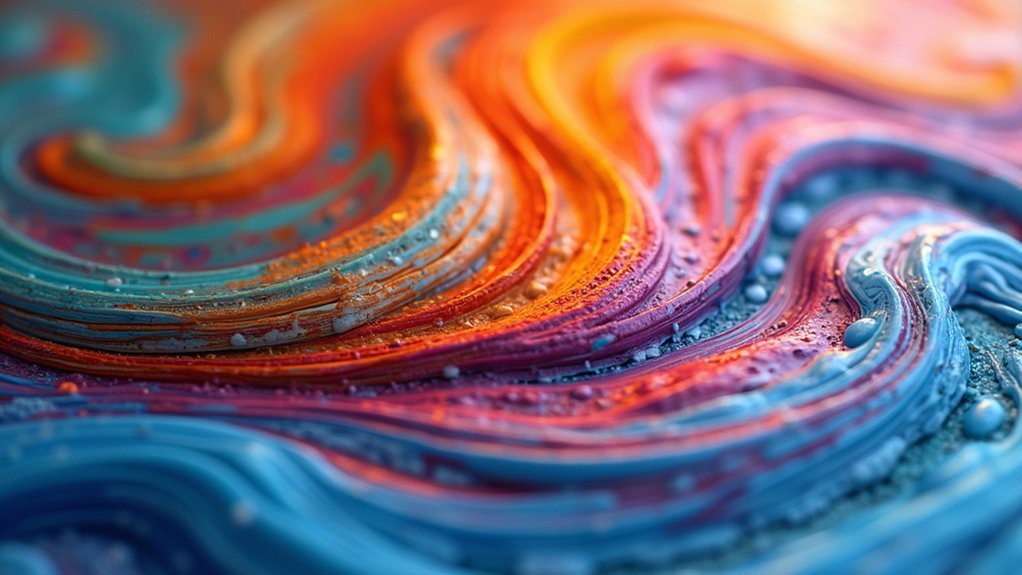
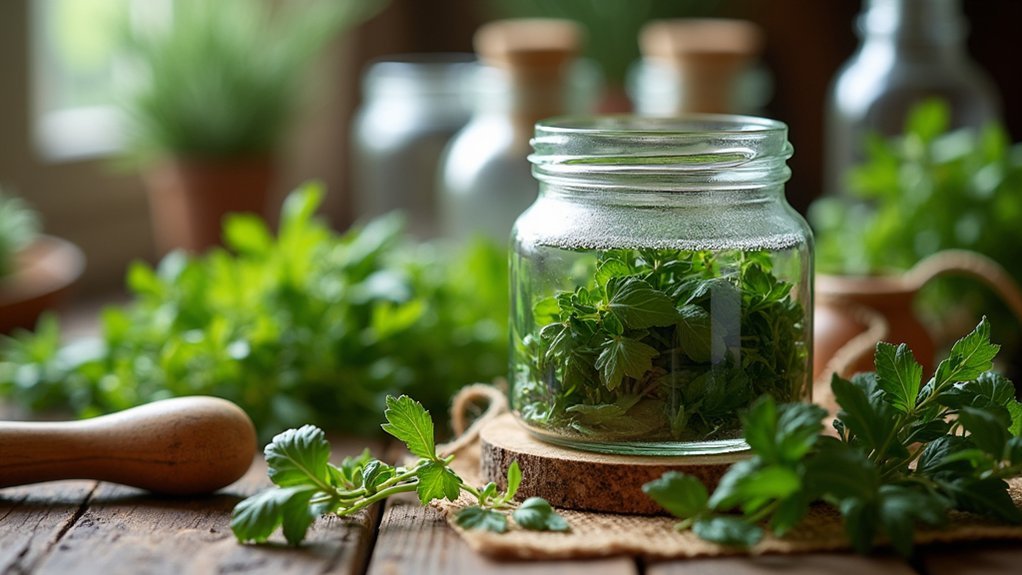
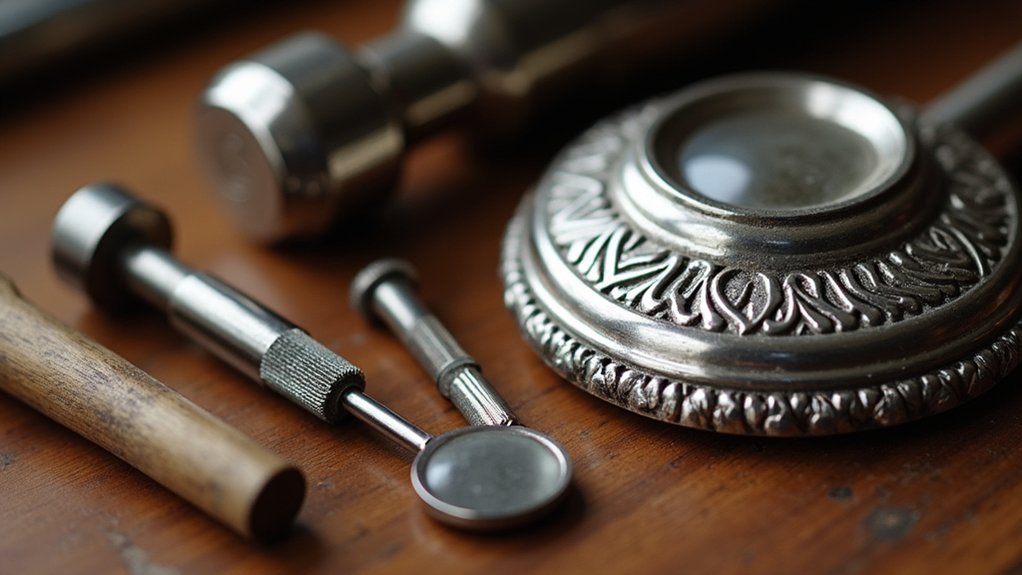
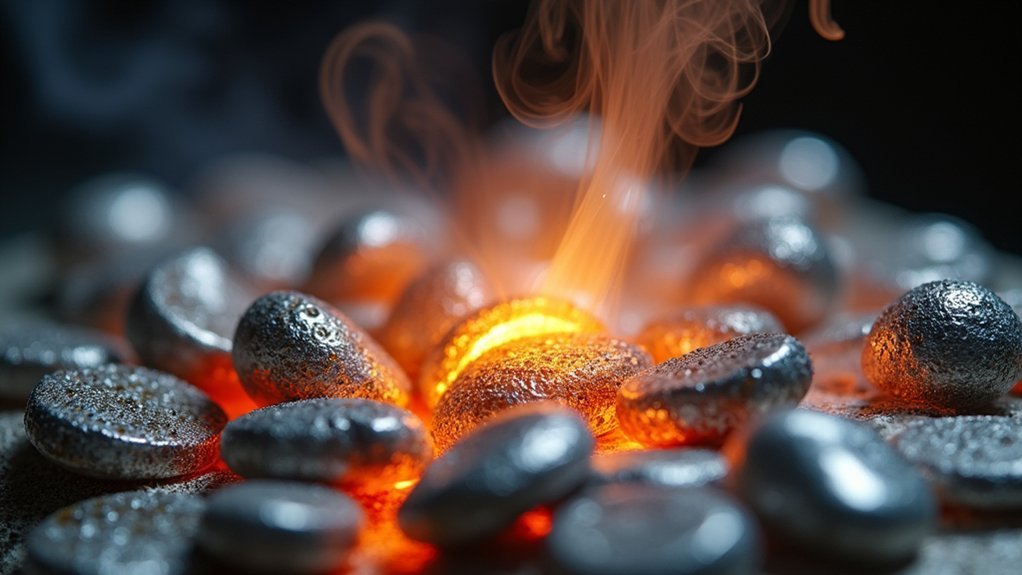
Leave a Reply